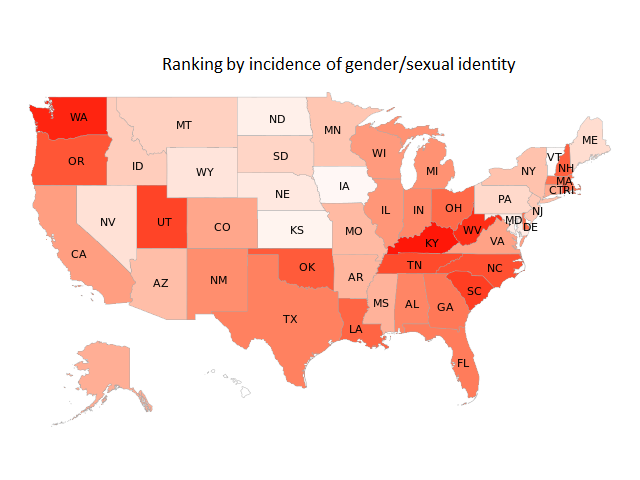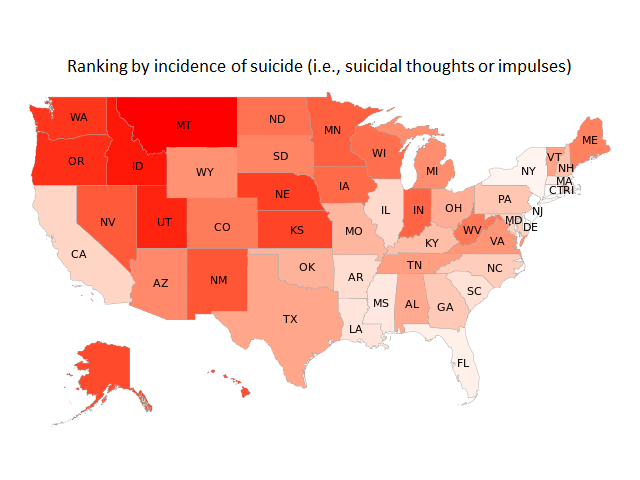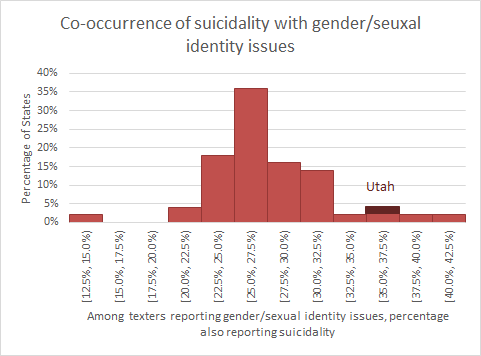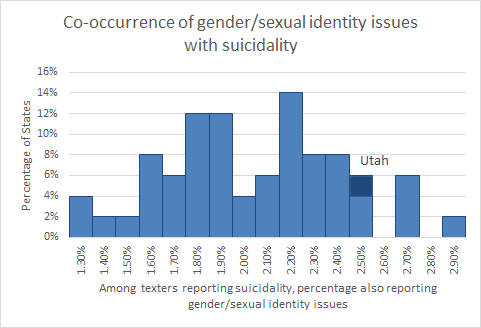Crisis Text Line is a support service for people in crisis. It’s like a suicide hotline, but more general in that the service has crisis counselors trained to respond to a broad range of crises. Also unlike a traditional suicide hotline, it’s reached by text rather than by voice. As a result of this, according to a New Yorker story from 2015 about the service, most who use it are teenagers.
Of particular interest to me, the organization also publishes aggregate data about what types of crises its clients contact them about, and from what states, as well as trends by day of the week, time of day, and across historical time (since 2015). I thought it would be interesting to look at these data to see if there were evidence of the particular stress that LGBT people are put under in Mormonism, particularly after the November 2015 exclusion policy came to light.
Unfortunately but not surprisingly, the Crisis Text Line data doesn’t include information about clients’ religious affiliation, so I’ll just use the rough approximation of using Utah data as a proxy for Mormon experience. On the up side, though, a big advantage of these data is that they summarize reports of clients’ crises by type–where I’ll just be looking at LGBT-related and suicidal thinking–rather than having only completed suicide counts to go on. Distress over one’s sexual orientation or gender identity and suicidal thinking are surely far more common than suicide itself, so these data are potentially richer than data on completed suicides alone.
Here’s a map that shows US states ranked by frequency of clients texting about issues of gender or sexual identity as a percentage of all texts received from the state. Utah ranks number seven.
It isn’t surprising that Utah ranks high here, but it maybe isn’t quite a slam dunk case for a Mormon connection, given that Idaho, which also has a fair number of Mormons ranks 38th, and Washington is number one, which I can think of no explanation for.
This next map shows US states ranked by the percentage of clients who text about suicidal thoughts. (If you go to their website, this is somewhat confusingly labeled “suicide,” but it’s clearly the issue of suicide that clients are texting about, and not counts of actual suicides.) Utah ranks number three.
As I understand it, it’s a typical finding that Utah is among the highest-ranked states in suicide rate, a fact that’s sometimes linked to the availability of guns. These data go beyond that finding, though, in showing that it also ranks high in terms of people having suicidal thoughts. It wouldn’t be surprising if there were some connection. At first glance anyway, a cluster of high-suicide-rate states in the CDC map linked earlier in this paragraph overlaps a lot with high-suicidal-thought states in this map.
The Crisis Text Line data they publish also includes percentage of clients who bring up one concern who also bring up another. So I thought it might be interesting to look at the co-occurrence of gender and sexual identity issues and suicidal thoughts to see if Utah stood out. For these data, they show actual percentages and not just ranks of the states, so I can look with a little more detail where Utah falls among the states.
This next graph is a histogram of the co-occurrence of suicidal thoughts with gender or sexual identity issues. In other words, the value being shown is the percentage of all clients who texted about gender or sexual identity issues who also brought up suicidal thoughts. The average for the states is between 25% and 30%. For Utah, it’s about 35%. I’ve highlighted the bar that Utah belongs to in the graph. It’s high, but it’s not the highest of the states, and it’s probably about where you’d expect it to be given that Utah is already known to be high on suicidal thoughts.
Finally, in this last graph I’ve turned the previous question around and looked at the co-occurrence of gender or sexual identity issues with suicidal thoughts. In other words, the value being shown is the percentage of all clients who texted about suicidal thoughts who also brought up gender or sexual identity issues. The average for states is about 2%. For Utah, it’s 2.5%. I’ve highlighted the bar that Utah belongs to in the graph. Again, it’s high, but not the highest, and it’s not higher than we would probably expect given that we’ve already seen that Utah ranks high on gender and sexual identity issues by itself.
The conclusion here isn’t very surprising. The data certainly seem to be consistent with the idea that Utah isn’t a comfortable place to be if you’re not straight and cisgender. It also looks like Utah may have an unusually large number of people who have suicidal thoughts. These two issues don’t appear to co-occur at levels beyond what would be expected given their high levels alone, but their high levels alone already tell a very sad story.
__________
Please note that I took these data from the Crisis Trends website a few weeks ago, and it appears that they update their data continuously, so what I’m showing is already a little bit out of date.


Arizona would be a great data point as well.